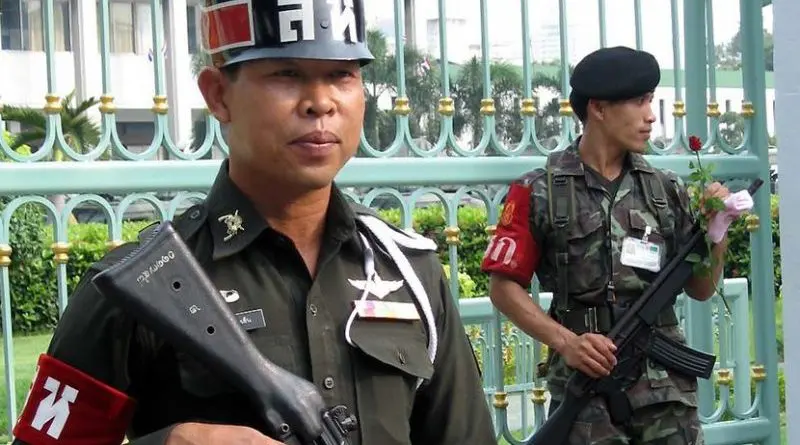Thai Military Strategy In The Deep South: Surveillance State – Analysis
The Thai military appear to have changed their strategy in the two-decade old insurgency that has cost 7,000 lives, mainly civilians, within the country’s deep south border provinces, adopting an aggressive new stance with new surveillance techniques and viewing the insurgents now more as criminals rather than separatists.
Over the past two years, the military has been negotiating with an umbrella organization, MARA Pattani, supposedly representing the insurgency groups within the south. Talks had appeared stalled until late last year, when it was announced that direct talks had opened with the main insurgency group Barisan Revolusi Patani (BRN).
Despite the BRN committing to negotiate an agreement with the Royal Thai Government, and unilaterally pledging to cease all activities during the Covid-19 pandemic, the military forces still undertook what appears to be a targeted raid on three insurgents at a house in Pakaruesong village, in Nongchik District, Pattani, during May.
Thai military anti-insurgency operations are directly under command of the fourth army, with its headquarters in Nakkhon Si Thammarat. The fourth army has hundreds of permanent bases within the southern provinces, and even more temporary bases in the border region, with more than 100,000 military and para-military personnel deployed.
Thai Army headquarters in Bangkok regularly sends down detachments and special personnel too carry out special training exercises, test new equipment, and develop tactics within the border provinces.
The military has traditionally favored soft-power approaches. Many infrastructure development projects have been initiated, and hearts and mind initiatives undertaken. Many of the middle ranking officers with a sense of history have an empathy to the cause of the insurgents and thus have seen a negotiated settlement as the most likely potential solution.
However, there has always been a hard line within the military, with an uncompromising view towards the insurgency. This group sees them as nothing more than a criminal element and terrorists who can be defeated by force. They believe that 1000-2000 insurgents and their sympathisers don’t have community support, and thus can be hunted out and dealt with harshly.
One of the military’s weaknesses is their lack of ability to collect human intelligence (HUMINT). There is no formal network of interpersonal intelligence gathering that yields intelligence that can be acted upon. The military has not been able to infiltrate any insurgency groups throughout the history of the uprising.
Thus it has undertaken the exponential development of surveillance technology with CCTV systems, biometric data and AI software that can match up and utilize biometric data within the CCTV system, now enabling the conduct of technological surveillance on a wide scale throughout the southern border provinces.
To operate a mobile phone within the southern provinces has long required user registration of the specific numbers. In June last year, the Internal Security Operations Command (ISOC) mandated that all mobile phone users were required to register their mobile phone SIM cards through a facial recognition system. Colonel Watcharakorn Onngon, deputy fourth Army spokesman, defended the new requirement, stating that the facial identification scheme is needed to identify insurgents deploying mobile phone detonated bombs.
In addition, the government has been collecting DNA samples to match with biometric data from residents of the southern border provinces. This information can be used as forensic evidence to assist in identifying perpetrators involved in violent incidents within the region. DNA material is forcibly collected when suspects are held in custody, at checkpoints, or during search operations at houses, dormitories, and Islamic schools. Reports indicate that “red zones” where the government believes insurgents are particularly active, with sympathisers are specifically targeted for forced DNA collection.
According to activists on the ground, government DNA and biometric data collection when phones are registered is producing a climate of fear among the ethnic Malay Muslim population, leading to resentment against the military. This has even led to some hesitancy towards health authorities undertaking Covid-19 tests among the Malay Muslim population. Forced DNA profiling of Malay Muslims in the south was criticized back in 2015 by the United Nations Human Rights Commission, as the practice could amount to ethnic profiling.
The combining of biometric and DNA data, along with an extensive CCTV system across the border region, now provides the military with a sophisticated surveillance tool in their counter-insurgency operations. AI software can be used to distinguish potential insurgents intermingled with the general population in towns across the region, at checkpoints, and in raids. This new integrated system potentially overcomes the army’s weakness in HUMINT intelligence gathering, and now gives the advantage the army has always been seeking, to be able to find insurgents.
One of the benefits of these systems is that physical military personnel can be withdrawn from town and city areas, as CCTV is now the primary means of surveillance. There are reportedly 8,200 surveillance cameras operating and controlled out of the Pattani Municipal Office CCTV Control Center.
As biometric surveillance is becoming the primary counter-insurgency tool of the military, there is the risk that the new surveillance strategy will undermine any future success of the peace talks. The BRN earlier in May condemned the actions of the government in taking forced DNA samples, along with the targeted killing of three BRN insurgents during Ramadan.
The new super-surveillance system is improving the army’s ability to seek out and suppress insurgency activities. It is an indication that insurgents are now seen as criminals, rather than separatists by the government. However, this may come at a cost with Malay Muslim disenchantment with the government’s data collection methods.
Originally published in Asia Sentinel


Thai army adopt US and Chinese strategies for monitoring insurgency. This article provides one-sided story. It ignores the criminal activities of the seperatists. Moreover, some fractions in Thai army support and train many separatists. If insurgency continues, the army will get more budget. Thai-Malay conflicts have started since 1290CE. I don’t see they will come to an end soon.